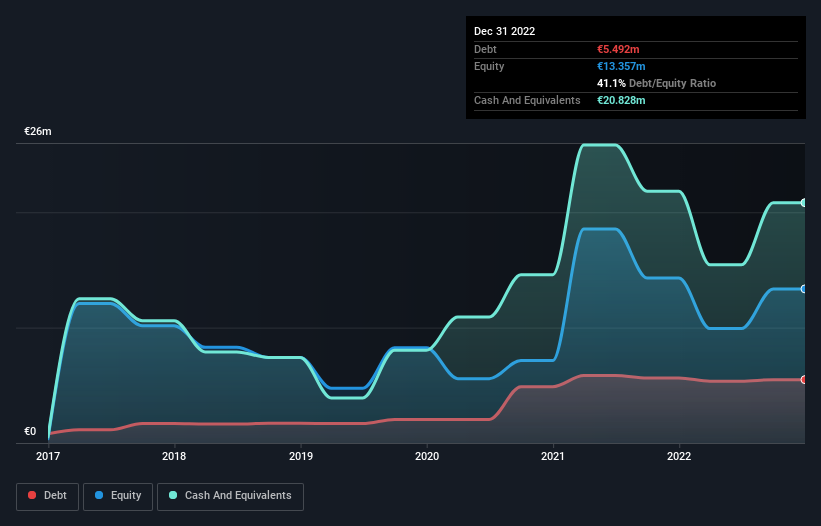Rock star Growth Puts Valbiotis (EPA:ALVAL) In A Position To Use Debt

Warren Buffett famously said, 'Volatility is far from synonymous with risk.' So it might be obvious that you need to consider debt, when you think about how risky any given stock is, because too much debt can sink a company. As with many other companies Valbiotis SA (EPA:ALVAL) makes use of debt. But the more important question is: how much risk is that debt creating?
What Risk Does Debt Bring?
Generally speaking, debt only becomes a real problem when a company can't easily pay it off, either by raising capital or with its own cash flow. Part and parcel of capitalism is the process of 'creative destruction' where failed businesses are mercilessly liquidated by their bankers. While that is not too common, we often do see indebted companies permanently diluting shareholders because lenders force them to raise capital at a distressed price. Of course, plenty of companies use debt to fund growth, without any negative consequences. The first thing to do when considering how much debt a business uses is to look at its cash and debt together.
Check out our latest analysis for Valbiotis
How Much Debt Does Valbiotis Carry?
The chart below, which you can click on for greater detail, shows that Valbiotis had €5.49m in debt in December 2022; about the same as the year before. But on the other hand it also has €20.8m in cash, leading to a €15.3m net cash position.

How Healthy Is Valbiotis' Balance Sheet?
According to the last reported balance sheet, Valbiotis had liabilities of €8.11m due within 12 months, and liabilities of €5.75m due beyond 12 months. Offsetting these obligations, it had cash of €20.8m as well as receivables valued at €2.78m due within 12 months. So it can boast €9.75m more liquid assets than total liabilities.
This excess liquidity suggests that Valbiotis is taking a careful approach to debt. Given it has easily adequate short term liquidity, we don't think it will have any issues with its lenders. Simply put, the fact that Valbiotis has more cash than debt is arguably a good indication that it can manage its debt safely. There's no doubt that we learn most about debt from the balance sheet. But ultimately the future profitability of the business will decide if Valbiotis can strengthen its balance sheet over time. So if you want to see what the professionals think, you might find this free report on analyst profit forecasts to be interesting.
In the last year Valbiotis wasn't profitable at an EBIT level, but managed to grow its revenue by 163%, to €785k. So its pretty obvious shareholders are hoping for more growth!
So How Risky Is Valbiotis?
By their very nature companies that are losing money are more risky than those with a long history of profitability. And in the last year Valbiotis had an earnings before interest and tax (EBIT) loss, truth be told. Indeed, in that time it burnt through €9.5m of cash and made a loss of €12m. With only €15.3m on the balance sheet, it would appear that its going to need to raise capital again soon. The good news for shareholders is that Valbiotis has dazzling revenue growth, so there's a very good chance it can boost its free cash flow in the years to come. While unprofitable companies can be risky, they can also grow hard and fast in those pre-profit years. There's no doubt that we learn most about debt from the balance sheet. But ultimately, every company can contain risks that exist outside of the balance sheet. Be aware that Valbiotis is showing 4 warning signs in our investment analysis , and 2 of those make us uncomfortable...
At the end of the day, it's often better to focus on companies that are free from net debt. You can access our special list of such companies (all with a track record of profit growth). It's free.
If you're looking to trade Valbiotis, open an account with the lowest-cost platform trusted by professionals, Interactive Brokers.
With clients in over 200 countries and territories, and access to 160 markets, IBKR lets you trade stocks, options, futures, forex, bonds and funds from a single integrated account.
Enjoy no hidden fees, no account minimums, and FX conversion rates as low as 0.03%, far better than what most brokers offer.
Sponsored ContentNew: Manage All Your Stock Portfolios in One Place
We've created the ultimate portfolio companion for stock investors, and it's free.
• Connect an unlimited number of Portfolios and see your total in one currency
• Be alerted to new Warning Signs or Risks via email or mobile
• Track the Fair Value of your stocks
Have feedback on this article? Concerned about the content? Get in touch with us directly. Alternatively, email editorial-team (at) simplywallst.com.
This article by Simply Wall St is general in nature. We provide commentary based on historical data and analyst forecasts only using an unbiased methodology and our articles are not intended to be financial advice. It does not constitute a recommendation to buy or sell any stock, and does not take account of your objectives, or your financial situation. We aim to bring you long-term focused analysis driven by fundamental data. Note that our analysis may not factor in the latest price-sensitive company announcements or qualitative material. Simply Wall St has no position in any stocks mentioned.
About ENXTPA:ALVAL
Valbiotis
Engages in the research and development of dietary supplements to prevent metabolic and cardiovascular diseases in France.
Good value with adequate balance sheet.
Market Insights
Community Narratives



